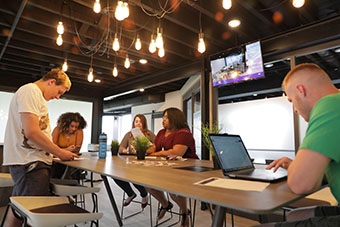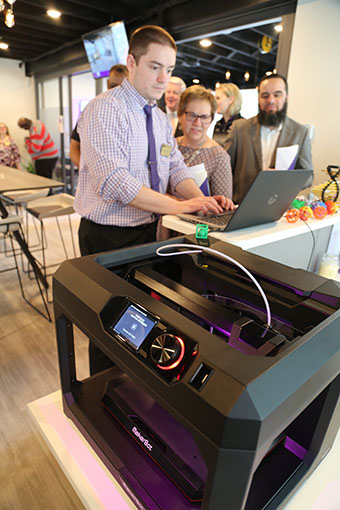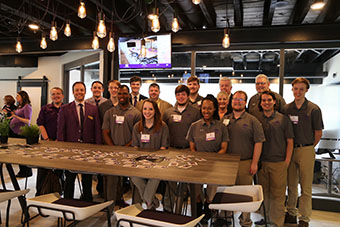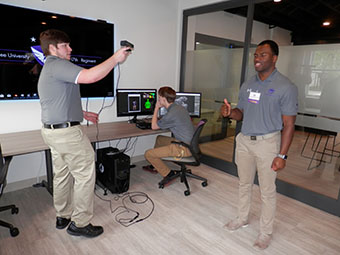New Cyber Programs Encourage Innovation & Collaboration

by Stephanie (Coartney) Dulaney ’10
If you’re like most people in this country, technology does more than just make your
life easier; it’s something our society has come to feel we can’t live without. In
the same way, technology’s presence in academia has become a necessary tool for learning
and pushing the boundary of what is possible in today’s world. It has led to new ways of
expressing creativity, problem solving, and connecting with people around the world
to not only share knowledge, but also utilize one another’s strengths to accomplish
a common goal. Technology is one of the most powerful forces shaping our lives today,
and McKendree’s new cyber programs and high-tech facilities are inspiring students
to continue making the “impossible” possible.
The 2017-2018 academic year at McKendree was truly the year of cyber growth on campus.
From the grand opening of theHub, the University’s technology-centric collaboration space, to the first competition
for the 117th Regiment Cyber Defense Team, spring of 2018 was filled with new beginnings
for exploration into cyber security and more active learning practices. One important
entity created this past year was the University’s one-of-a-kind Cyber Academy. This
overarching organization for cyber activity on campus focuses on enhancing student
learning through unique projects and partnerships related to cyber security issues.
“The Academy aims to unite students from all fields of study with business and industry
professionals, law enforcement, government, and regional community leaders. They learn
about the vulnerabilities, threats, and opportunities in cyberspace through innovative
ideas and programs,” said Daryl Hancock, chief of staff and executive director for McKendree Worldwide. “It integrates educational
opportunities with community service, cyber competitions and games, conferences, symposiums, and
workshops to create a regional platform for cyber education at McKendree.”
To accommodate this kind of hands-on learning, University leaders knew students would
need a high-tech facility that made creativity and idea-sharing easy. Thus, the lower level
of Pearsons Hall was transformed into theHub, a modern space with a “start-up company”
inspired layout conducive to collaboration. Some of the tools available to students
in theHub include 3-D printing and modeling, virtual reality software, and drone building.
The facility’s 24/7 access and seating capacity of 50 includes three conference spaces
separated by glass walls with a fogging feature that creates more privacy and can
be used for projection when needed.
“theHub gives students the opportunity to learn how to best use the technology within
their discipline while simultaneously opening the door for them to discover new ways
they can implement it in their daily lives,” said George Kriss MBA ’08, director of information technology and Cyber Defense Team coach. “We view this space as a ‘living space’ that will flex
and change as technology shifts. These pivoting capabilities will allow students to
have exposure to the most cutting-edge tech at the time, in order to further their
marketability beyond the classroom.”
One of the rooms in theHub, the Vangampler Room, was made possible through a donation
by Glen and Loretta Vangampler. Named in memory of their son and computer science alum, Glen Arthur “Artie” Vangampler ’89, the space functions as a large meeting room, group study area or classroom. Other
areas within theHub are also available for naming.
The Range is another area of theHub that serves a wide array of functions. Primarily,
it is the home base and practice area for the University’s first-ever Cyber Defense Team.
Named after the historic McKendree Civil War regiment, the 117th Regiment Cyber Defense
Team began competing just six weeks after forming in January 2018. During competitions,
the team faces off against other universities as they each attempt to protect a mock network
from external “hackers” attacking their computer system. In spite of limited time
to train and prepare, the McKendree team placed in the top five at the Midwest Regional
Cyber Defense Competition in Chicago, holding its own against universities with longstanding
cyber defense teams, such as the University of Illinois and DePaul University. Team captain senior Kevin Magee said he couldn’t be happier with their successful
first competition, and the group has even more planned for the 2018-2019 season. “Just
being a part of this team has given me great hands-on experience,” he said. “We are
setting up systems we didn’t have last year and now know what to expect at these competitions.
This year, we will be competing in two or three different kinds of competitions with
multiple systems that the team must defend, attack, or both at the same time. Through
what we learn from these competitions, team practices and class time, we also want
to help make the campus more aware of cyber threats, and we’re beginning to talk about
providing services for local businesses, too.”
Team captain senior Kevin Magee said he couldn’t be happier with their successful
first competition, and the group has even more planned for the 2018-2019 season. “Just
being a part of this team has given me great hands-on experience,” he said. “We are
setting up systems we didn’t have last year and now know what to expect at these competitions.
This year, we will be competing in two or three different kinds of competitions with
multiple systems that the team must defend, attack, or both at the same time. Through
what we learn from these competitions, team practices and class time, we also want
to help make the campus more aware of cyber threats, and we’re beginning to talk about
providing services for local businesses, too.”
A Cyber Club has been formed for students interested in cyber security who may not
want to be on the competitive team. In June 2018, the organization’s first sponsored
event was a CyberPatriot summer camp, which attracted more than 200 high school and
middle school students to campus for a week-long series preparing them for a national
cyber defense competition. McKendree Cyber Club and Cyber Defense Team members helped
work with the students to hone their skills and learn new tactics in cyber security.
“It was exciting to have this many students able to see our campus and our new spaces
and to work with them together on cyber security,” George said. In the classroom, McKendree also expanded its curriculum to include a new undergraduate
business course in cyber security last year. The class introduced students to key issues
in cyber security through speakers from IBM, FireEye and Midwest Cyber Center, as
well as active learning projects, such as a phishing email sent to the entire campus.
Meant to trick users into inputting personal information, phishing emails often have
the appearance of a legitimate source, but are in fact created by scammers to steal
users’ identities or other information. The project opened students’ eyes to the ease
with which scammers can accomplish their goals and inspired the class to launch a
phishing awareness campaign on campus.
In the classroom, McKendree also expanded its curriculum to include a new undergraduate
business course in cyber security last year. The class introduced students to key issues
in cyber security through speakers from IBM, FireEye and Midwest Cyber Center, as
well as active learning projects, such as a phishing email sent to the entire campus.
Meant to trick users into inputting personal information, phishing emails often have
the appearance of a legitimate source, but are in fact created by scammers to steal
users’ identities or other information. The project opened students’ eyes to the ease
with which scammers can accomplish their goals and inspired the class to launch a
phishing awareness campaign on campus.
This year, the University will add even more cyber-related elements into its academic offerings
in the form of two new majors.
Management Information Systems (MIS) and Data Analytics each blend elements of technology with concepts that students
can apply to a variety of career fields. Combining courses in computing and business, the
MIS major will explore the ways these two areas of study intersect and provide students
with a thorough understanding of technology in the business world. Similarly, the
new Data Analytics major also spans different academic disciplines as it focuses on
blending concepts in mathematics, statistics and computer science to extrapolate findings
from large, complex data sets. Students can further select how they want to apply
this major by choosing to earn either a Bachelor of Arts in Data Analytics, useful
in psychology and sociology fields, or a Bachelor of Science in Data Analytics, which
focuses more on the usage of data in business and economics.
The growth of technology has led to incredible achievements that have transformed
what were once just ideas into reality. At McKendree, the tradition of equipping students
with the opportunity to realize their dreams continues in the newest technology tools
and programs designed to help them succeed in an ever-changing world.

